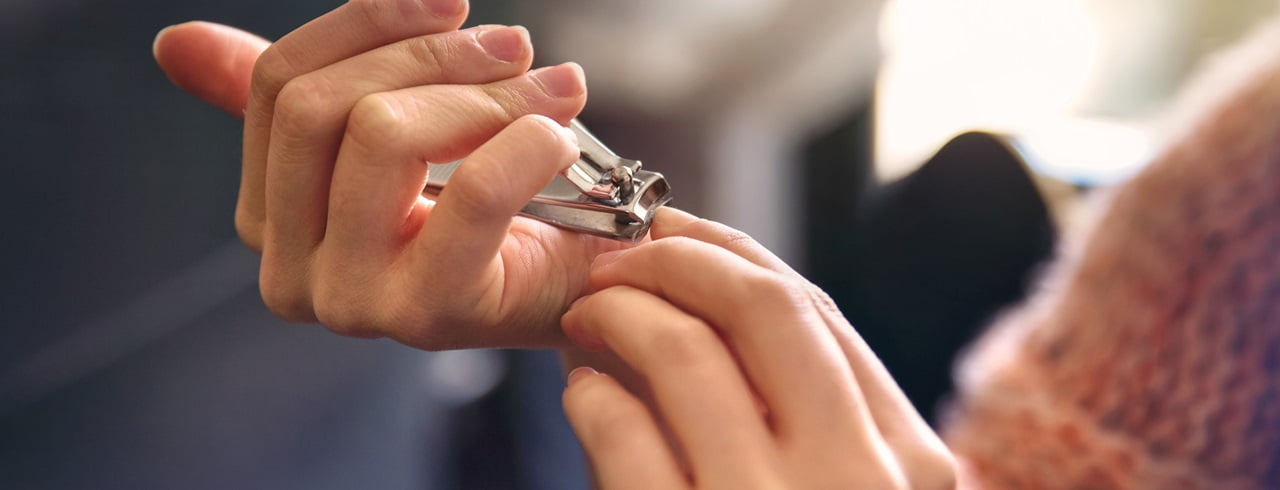
How to take good care of your fingernails and toenails
Healthy, good-looking nails aren’t just important during sunbathing season. Taking proper care of your fingernails and toenails also helps prevent health problems. Find out in this health tip how to take good care of them.
It’s high season down at the open-air pool. A good proportion of the women there have brightly coloured fingernails and toenails. But taking care of your nails doesn’t just mean applying a bit of coloured nail polish. Both men and women should take proper care of them.
If you have surplus skin (cuticle) around the sides of your nails or the crescent-shaped lunula, never remove it with normal scissors or tear it off. The risk of injuring yourself is too great. It’s best to remove the cuticle with specially designed nippers or rosewood sticks. Prior to that you should soften it with a hand bath or the appropriate oil. As a precaution you can also disinfect the skin with regular sanitiser to prevent infection if you cut too deep by accident when removing your cuticles.
12.08.2020
Anatomy of your nails
Fingernails and toenails are between 0.05 and 0.75 millimetre thick and are made of a fibrous substance called keratin. Each nail consists of multiple, irregularly overlaid layers of horny cells. Nails are designed to protect your fingertips and make it easier to pick objects up.Trimming fingernails and toenails properly
Nails generally grow around 0.5 to 1.2 millimetres a week. This means you have to cut your fingernails and toenails from time to time. There are a few things to look out for:- Always cut your nails while they’re dry, because when you use scissors or clippers there’s always the risk of tearing or cracking them.
- Never cut your nails right back. Always leave around one millimetre extra and use a nail file to remove the rest.
- To prevent tearing or cracking, always file your nails in the direction of growth.
- Avoid metal files. They quickly heat up and can damage your nails. It’s best to use files made of wood or fibreglass.
If you have surplus skin (cuticle) around the sides of your nails or the crescent-shaped lunula, never remove it with normal scissors or tear it off. The risk of injuring yourself is too great. It’s best to remove the cuticle with specially designed nippers or rosewood sticks. Prior to that you should soften it with a hand bath or the appropriate oil. As a precaution you can also disinfect the skin with regular sanitiser to prevent infection if you cut too deep by accident when removing your cuticles.
Ingrowing nails
Ingrowing nails are usually the result of cutting or filing your nails incorrectly. But in many cases people only notice the problem when their inflamed nail starts to hurt badly. The treatment depends on the inflammation and pain you’re experiencing. If the problem’s minor you can consult your pharmacist. If you’re in too much pain you’ll have to go to the doctor or podiatrist. In the worst case you may even need surgery to remove the ingrown nail.santé24 – your Swiss telemedicine service
Health advice around the clock: The doctors and medical specialists at santé24 are there to offer you expert advice on all questions relating to prevention, illness, accident and maternity – in four languages, around the clock, 365 days a year. Advice is free of charge to SWICA customers.12.08.2020
In the event of further health-related questions, SWICA customers can contact the santé24 telemedicine service free of charge on +41 44 404 86 86. A telemedicine practice licence allows santé24 physicians to provide additional medical services in cases that are suited to a telemedicine approach. SWICA customers can also use the BENECURA medical app to carry out a digital SymptomCheck and receive recommendations about what to do next. During a subsequent phone call with santé24, customers can decide for themselves whether to release their information from SymptomCheck to santé24.




